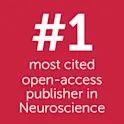
Impact analysis
14 Dec 2015
Quality and Impact Analysis: the Field of Frontiers in Neuroscience
For the second year on a row, Frontiers is the #1 most cited and largest open-access publisher in the category of Neuroscience.

Impact analysis
14 Dec 2015
For the second year on a row, Frontiers is the #1 most cited and largest open-access publisher in the category of Neuroscience.

Impact analysis
05 Nov 2015
By Pascal Rocha da Silva, Frontiers analyst The field of Frontiers in Neuroscience, established in 2008, has become the #1 most cited and #1 largest Open Access publisher of Neuroscience and the 3rd most cited and 4th largest Neuroscience publisher overall. The impact factor (IF), defined as the total number of citations divided by the number of citable articles over a two-year period, is the gold standard of journal quality (not of an individual scientist). It was formally established by the Institute for Scientific Information (ISI) in 1975. As the IF can be heavily skewed by a few highly cited papers, total citations generated over the same two-year period provide a more accurate measure of the overall influence or impact of the articles published by a journal in a field. Analysis within the JCR category of Neuroscience There are 252 journals listed within the category of “Neurosciences” in the 2014 Journal Citation Reports (JCR), provided by Thomson Reuters in 2015. There are 36 Gold Open Access journals indexed in the 2014 JCR. Frontiers is structured by academic fields (e.g. Neuroscience, Psychology, Plant Science, etc.) with specialty sections (e.g. Developmental Psychology). In the case of the field of Frontiers in Neuroscience, […]

Frontiers news
02 Nov 2015
By Pascal Rocha da Silva, Frontiers analyst Frontiers in Human Neuroscience was launched in 2008. In just 6 years, it has become the #1 most-cited journal in psychology, the #1 most-cited open access journal dedicated to neuroscience and the 10th most-cited journal in all of neuroscience. It is also the 2nd and 3rd largest journal in all of psychology and neuroscience, respectively. The Impact Factor (IF), defined as the total number of citations in a given year divided by the number of citable articles over the previous two-year period, is the most commonly accepted metric of journal quality (but not of an individual paper or researcher). It was formally established by the Institute for Scientific Information (ISI) in 1975. As the IF can be heavily skewed by a few highly-cited papers, total citations generated over the same two-year period provide a more accurate indication of the overall influence or impact of the articles published by a journal in a field. Frontiers is a pioneer in the use of article-level and author-level metrics and encourages every author to use these to track the development of his or her readership on a more granular level. Analysis within the categories of Neuroscience and Psychology There are 252 journals listed in the category of Neurosciences in the […]
Get the latest research updates, subscribe to our newsletter